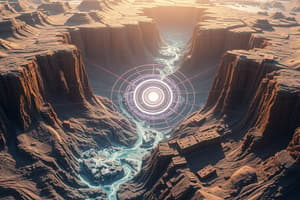Podcast
Questions and Answers
What is the seismometer?
What is the seismometer?
- The point on the earth’s surface diametrically opposite to the epicenter
- The internal part of the seismograph used to record the motion of the ground during an earthquake (correct)
- The place of origin of the earthquake in the interior of the earth
- The recordings of the ground shaking at the specific location of the seismograph
What is the epicenter of an earthquake?
What is the epicenter of an earthquake?
- The point on the earth’s surface diametrically opposite to the epicenter
- The place on the earth’s surface directly above the center of the earthquake (correct)
- An imaginary line joining the points of same intensity of the earthquake
- The place of origin of the earthquake in the interior of the earth
What does an isoseismal represent?
What does an isoseismal represent?
- The point on the earth’s surface diametrically opposite to the epicenter
- An imaginary line joining the points of same intensity of the earthquake (correct)
- The recordings of the ground shaking at the specific location of the seismograph
- The place of origin of the earthquake in the interior of the earth
Which term refers to the destruction caused by an earthquake at its worst point?
Which term refers to the destruction caused by an earthquake at its worst point?
What is the coseismal?
What is the coseismal?
In homogeneous grounds with plain surfaces, what happens to the isoseismal and coseismal?
In homogeneous grounds with plain surfaces, what happens to the isoseismal and coseismal?
What is magnitude in relation to earthquakes?
What is magnitude in relation to earthquakes?
How is intensity represented?
How is intensity represented?
What type of faulting dominates at a constructive plate boundary?
What type of faulting dominates at a constructive plate boundary?
What type of boundary is formed when plates move towards each other?
What type of boundary is formed when plates move towards each other?
Where do most of the earthquakes with magnitudes greater than 6.0 occur?
Where do most of the earthquakes with magnitudes greater than 6.0 occur?
What type of faulting is dominant at a transform boundary?
What type of faulting is dominant at a transform boundary?
Which type of earthquake is characterized by a focus depth of more than 250 km?
Which type of earthquake is characterized by a focus depth of more than 250 km?
What type of earthquake is exclusively due to internal causes such as disturbances in geological formations?
What type of earthquake is exclusively due to internal causes such as disturbances in geological formations?
What type of boundary is formed when tectonic plates move apart from each other?
What type of boundary is formed when tectonic plates move apart from each other?
What is the approximate range of thickness for tectonic plates in the Earth's crust?
What is the approximate range of thickness for tectonic plates in the Earth's crust?
Flashcards are hidden until you start studying




